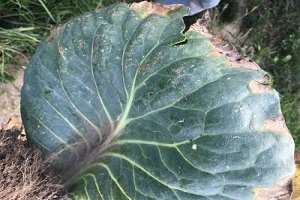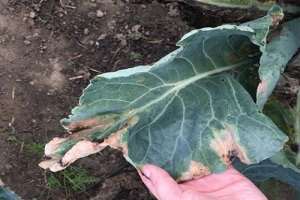By Marissa Schuh
With late-season temperatures in the high 70s, foggy mornings with high humidity and numerous rainy days, many growers of brassica crops, in particular cabbage, are noticing an uptick in a disease that can render produce unmarketable – black rot. The disease first manifests itself as dull yellow areas on the leaf margin, often 1-3cm in size and extending downwards in a V-shape. The center of this area often becomes brown and dry, and as the disease advances, the plant will take on a scorched appearance. The symptom for which the disease is named is a blackening of the veins, which is followed by soft rot (most apparent in cauliflower and cabbage).

This disease is caused by the bacterium, Xanthomonas campestris pv. campestris, which can enter the field on transplants or seeds, and can stay in the soil for over a year where it survives on debris and weeds in the Brassicaceae family. The bacteria move primarily with water and can enter the plant through pores naturally present on the leaf surface. It can also be spread by workers and equipment moving through the field, and can enter the leaves through damage caused by hail, insects and other mechanical injuries.
Temperatures of 77 degrees Fahrenheit or above hasten movement of the bacteria within the plant, leading to the onset of symptoms. The uptick in disease earlier this month is likely the result of extended periods of rainy and humid conditions (such as foggy mornings), warm days and increased field activity, all of which will allow the bacteria to spread and develop.

Unfortunately, growers have limited means to control this disease, especially this late in the season. If there is a history of black rot in a field, Michigan State University Extension advises growers be diligent in destroying residue, as plowing diseased crop under as soon as possible will allow tissue to break down sooner. It is also important to rotate out of any crops in the Brassicaceae family for three to four years (remember to include cover crops in these rotational considerations).
The pathogen spreads easily via puddles of water and splashing, so increasing distance between fields and choosing well-drained fields may also hinder spread. Weeds in the mustard family are another consideration, so control weeds such as shepherd’s purse, wild mustard and pepper weed. Fumigation can be effective in transplant seed beds – although most transplants are now produced in plastic trays – and whole field fumigation is likely too expensive.
Controlling black rot starts with disease-free seed; hot water treatment can reduce the likelihood that the bacteria will enter the field through the seed. A general guideline for seed treatment is to soak the seeds of cabbage, broccoli and Brussels sprouts at 50 degrees Celsius (122 F) for 25-35 minutes, and the seeds of cauliflowers, kohlrabi, kale, rutabaga and turnips for 15 minutes. Another option for some cole crops, such as cabbage, is to plant a resistant variety.
Caution must continue into the process of transplant production. Greenhouse sanitation is important and includes keeping plant tissue from previous crops out of the transplant production area, as any soil or plant residue could be harboring bacteria and other pathogens. Use new plug trays or clean used trays with heat or a greenhouse disinfectant that is refreshed frequently. Visually assess or test young plants for black rot before transplanting.
According to the “Midwest Vegetable Production Guide for Commercial Growers,” products that may limit the spread of the black rot bacterium include Actigard (0.5-1 ounce per acre, seven-day pre-harvest interval) and copper. It is important to remember that in some situations, applying high rates of copper may result in speckling in wrapper leaves. Once the disease is evident, there are no good solutions available. Always read instructions on the label and follow label rates.
For more information on how to recognize and manage black rot, see “Black Rot of Crucifers” by Cornell University Extension and “Managing Black Rot of Cabbage and other Crucifer Crops in Organic Farming Systems” by Christine Smart and Holly Lange of Cornell University.
Source: msu.edu